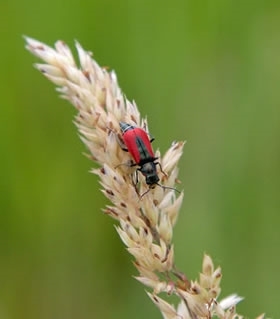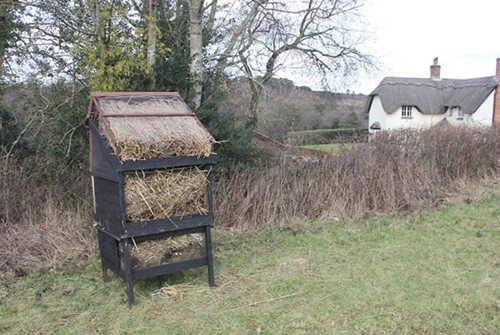 This blog post originally appeared on Peter's 'Fresh from the Field' blog on 13th March 2016.
This blog post originally appeared on Peter's 'Fresh from the Field' blog on 13th March 2016.
I do like discovering a “new” species that I have been blissfully unaware of, until someone happens to mention it and sets me off to find out more about it! The Scarlet malachite beetle Malachius aeneusis is just such a species, a beautiful red and green insect found in only three counties (Hampshire, Essex & Hertfordshire) on just eight sites in the UK.
The beetle emerges in early May and will be out and about until the middle of June. It used to be widespread in the southern half of the country, but is believed to have declined enormously, although it may well be lurking in undiscovered places, waiting for its whereabouts to be revealed by an eagle-eyed naturalist.
The most distinctive things to look for when identifying the scarlet malachite beetle is its bronze-green coloured body and section where the two wing cases meet, its bright red wing cases and it’s yellow face. It can be found feeding on a range of plants, although the buttercup does seem to be a particular favourite.
It has quite a strange life cycle does the scarlet malachite, but Ian Hughes, a freelance naturalist with support from Natural England and Buglife, is on a mission to secure the future of the handsome beetle, by shedding more light onto what it gets up to during the year.
Ian explains, “I do believe that the loss of meadow habitat in this country is partly responsible for the beetle’s dramatic decline and this is one of the elements of their life-cycle that I am investigating. They appear to need thatched properties to lay their eggs, and once hatched in early May they need a direct flight path from the thatch to a meadow habitat where they need to feed on specific meadow flowers and grasses and then breed.”
 Potential Scarlet Malachite beetle residence!
Potential Scarlet Malachite beetle residence!
It might also be that modern thatched roofs may offer a less good habitat than they used to, perhaps because they are kept in better condition than in days gone by. Also quite a lot of thatching straw is imported from Poland nowadays and most of it is treated with chemicals to help it last longer.
So, Ian is installing small but perfectly formed thatched ‘beetle cottages’ on sites where the beetle once thrived, in the hope that they may to choose to lay their eggs there. Not only should this give the beetles exactly what they require, but also help Ian to study the beetle at close quarters, which is not the case normally, as he can’t clamber around over people’s houses!
To help secure the future of this threatened species, Natural England has also come to the rescue by providing advice and financial support through its Innovation Fund. David Andrews, Natural England’s adviser in the New Forest has been supporting Ian and said, “The beetle is a national priority species and therefore features in Natural England’s species recovery plan.
“We would urge people to go out and look out for the beetle this spring and early summer so that we can assess the current state of play for this beetle in Britain and potentially find previously unknown territories. It is a stunning and unmistakable looking beetle and it seems to be clinging on in just a tiny portion of its former range. It could be that with the help of the public and landowners we might uncover other areas where the beetle is surviving. This would be a fantastic discovery and could make a massive difference to their survival.”
To take part in the survey, please visit Buglife’s website.

Get the FREE weekly GWCT newsletter
Get all of Peter's and the GWCT's latest blog updates sent straight to your inbox each Tuesday.
Sign up FREE to the Weekly GWCT Newsletter >